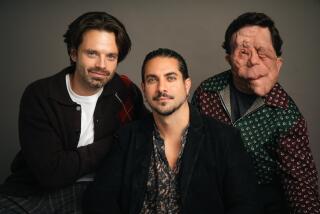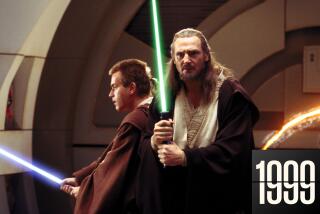Short film meant to accompany ‘Empire Strikes Back’ makes a comeback
For decades it was a missing relic of the “Star Wars” era: an Arthurian tale about a knight returning from the crusades who is transported to a mystical realm where he must rescue a princess.
Called “Black Angel,” the 25-minute movie was written, directed and produced in 1979 by Roger Christian, an art director who won an Academy Award for his set decoration work on “Star Wars.”
“Black Angel,” which was made with the support of “Star Wars” director George Lucas, was screened in Europe and Australia as a short film just before showings of “The Empire Strikes Back” in 1980.
It was never screened again.
ON LOCATION: Where the cameras roll
Until recently, Christian had assumed the original film prints were lost. Now, thanks to a serendipitous discovery by an archivist at Universal Pictures and services volunteered by Emeryville, Calif., visual effects company Athena Studios, the movie has come back to life.
This week a digital restoration of the movie made its North American theatrical premiere at the 36th annual Mill Valley Film Festival in Marin County. Christian plans to release the film on Netflix and Apple’s iTunes early next year.
“I’ve waited three decades to be able to show this film to audiences once again,” Christian said. “I’m so grateful.”
The London native, now 69, had just finished work on Ridley Scott’s “Alien” and Monty Python’s “Life of Brian” when he decided to take the leap from decorating and designing film sets to directing his first feature.
He saw his opportunity when he learned that Lucas was dissatisfied with the short film that had accompanied the original “Star Wars” in Britain. For “The Empire Strikes Back,” Lucas wanted a film that was more compatible with his movies’ themes.
PHOTOS: Hollywood Backlot moments
Christian had gone back to school to study film direction. While a student at the National Film School near London, he wrote a script for “Black Angel,” a romantic tale that, like Star Wars, was influenced by legendary Japanese filmmaker Akira Kurosawa.
Lucas liked the script and instructed executives at 20th Century Fox to let Christian make the movie with the help of a British government grant worth about $50,000.
“George said, ‘Go and make it,’” Christian said.
Traveling in a Volkswagen camper bus and towing a horse trailer, Christian took a crew of 13 people to the rugged western Highlands of Scotland, where they filmed at Eilean Donan castle. They used a local school pool to film an underwater scene, and shot the entire movie in just seven days.
To save money, Christian used leftover rolls of film from “The Empire Strikes Back.” He also relied on makeshift practical effects, including a spray can for simulating cobwebs. He used slow motion in some battle scenes to make the film longer.
The movie was released in 1980 with screenings of “The Empire Strikes Back” in Britain, some other European countries and Australia.
PHOTOS: Celebrities by The Times
“Black Angel,” however, was never shown in North America, where theaters at that time were no longer screening short films before major features, unlike their counterparts in Europe.
Nonetheless, the film’s style and look influenced several other fantasy films, including the 1981 film “Excalibur.”
Christian says he wanted to release the move on VHS and DVD but had lost track of the original film prints. Boss Films, where he had worked, had gone out of business and had discarded the film’s negatives. Archivists at Fox, which produced more than 400 prints of the film, and Lucasfilm couldn’t locate any copies of the film.
Christian had concluded the movie had been lost until he got a call in December 2011 from an archivist at Universal who had found the original negatives.
“He said, ‘I’ve got your negatives here,’” Christian said. “It was the best Christmas present I’ve ever had.”
After reading about the film in Wired magazine last year, Brice Parker, a producer at Athena Studios, and his colleague David Tanaka, Bay Area chair of the Visual Effects Society, offered to supervise the film’s restoration for free.
HERO COMPLEX: ‘Star Wars’ coverage
They sent the negatives to Hollywood postproduction company Efilm, which cleaned and digitally scanned the negatives, also for free. Athena’s restoration team spent 12 weeks removing splice marks, dust and other blemishes that had been transferred from the original negatives. Using a software program, frames were restored and then a digital intermediate was color corrected. After that a new digital version of the film was created.
“David and I were both huge ‘Star Wars’ fans, and this was one of the missing relics from the ‘Star Wars’ era, and we knew we had an opportunity to bring it back,” Parker said.
Jon Peters, founder of Athena Studios, said it was an “honor to help bring this historical work back to life so that it may be enjoyed again after having been considered ‘lost’ for over 30 years.”
Tanaka, a former visual effects editor at Lucas’ Industrial Light & Magic, said he was drawn to the project because of the digital restoration work he did on the original “Star Wars” movies.
“I saw this as exactly the kind of thing that we should be supporting,” he said. “This is something that has roots with ‘Star Wars.’ It’s part of our history.”
More to Read
From the Oscars to the Emmys.
Get the Envelope newsletter for exclusive awards season coverage, behind-the-scenes stories from the Envelope podcast and columnist Glenn Whipp’s must-read analysis.
You may occasionally receive promotional content from the Los Angeles Times.











